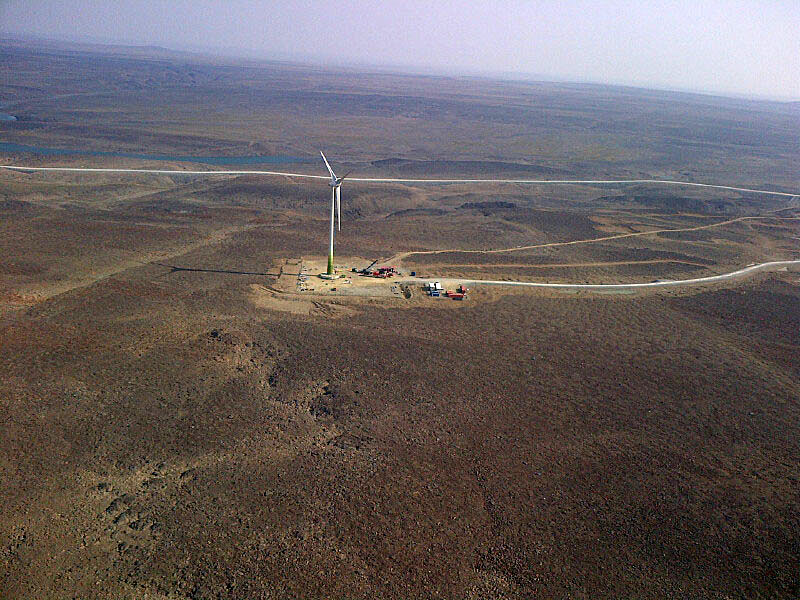Two Nunavut hamlets experiment with wind, solar energy
The hamlets of Arviat and Kugluktuk have decided to work on new clean energy projects to reduce diesel use.
If all goes well, solar panels will be installed in both communities by late fall of 2018, a move that will see diesel use, and thus carbon emissions, displaced by about 15 percent.

The two hamlets are working on hybrid renewable energy projects with a company called NStor Remote Communities.
NStor has developed a technology for storing energy — crucial when considering solar and wind power because storage helps even out the distribution of energy during times when sun or wind is not available.
A branch of the firm, NStor Remote Communities, works with remote and off-grid communities to reduce dependence on diesel fuel.
After the solar panels are installed, the company plans to install wind technology. At that point, each community should see its reliance on diesel fuel cut in half.
But first, each hamlet needs the federal government to approve its project funding.
“This innovative clean energy project will be the first major renewable energy project in Canada’s North,” Arviat Mayor Bob Leonard said, in a Sept. 18 news release.
“I don’t think we set out to be green, we just set out to do things right, to do things properly, to think of the future,” Leonard later told Nunatsiaq News.
He said the federal government’s upcoming carbon tax has the Government of Nunavut looking for ways to reduce carbon emissions in the territory.
“I think that’s what has us pushing for more wind generation than we originally planned on,” he said.
The partnership between Arviat and NStor Remote Communities started three years ago when members of the hamlet approached the company at a conference.
Company representatives have since met with the Arviat hamlet council and the community’s hunters and trappers organization.
“We’re excited about it,” Leonard said.
“We have been pushing for hydro power from Manitoba… Going for this one doesn’t mean we’re not looking for hydro power,” he said.
“It would just all add to what we are capable of doing here.”
This winter, NStor will gather wind data in each hamlet using recently installed towers called met masts. The company needs at least a year’s worth of data to plan the installation of a wind turbine.
And, while solar power is consistent and low maintenance, “if you want to create a lot of power fast, you need wind,” Leonard said.
While the hamlet is optimistic about the new energy move, Leonard said meeting project timelines will depend on money from Ottawa.
“The initial plan was really ambitious,” he said. The company had hoped to put solar panels up this year.
Ron MacDonald, President of NRStor Remote Communities, said the project is “at a tipping point” while the two parties work on funding applications.
A portion of the project has been supported by Polar Knowledge Canada, the federal agency responsible for advancing Canada’s knowledge of the Arctic.
“We want a substantial reduction in greenhouse gases,” MacDonald said.
And, he said the hamlet will see financial as well as environmental benefits from the new energy project.
“It’s a business venture. They get ongoing dividends for the life of the project,” he said.
MacDonald said the company also needs to do research on best energy storage practices so that there are stores of energy for communities to rely on when it isn’t windy, or when the sun isn’t shining.
Kugluktuk started using solar energy in 2016 when it installed a 10kW rooftop solar system on the community’s recreation complex.
This new project in Kugluktuk and Arviat will build on that head start to create “a reliable and modern, low-carbon energy system,” said a Sept. 20 news release.
“With the growth in our community over the last five years, we realize that the operational cost of energy is going up and we must find ways to reduce cost. We see renewable energy as an opportunity to cut costs and enable the growth of our community,” Kugluktuk Mayor Ryan Nivingalok said in the release.
In January, the University of Waterloo released a study identifying five Nunavut communities that would most benefit from a mix of renewable energy and diesel power.
Arviat was on that list, but Kugluktuk was not.
Slowly, it seems, Nunavut communities are embracing alternative energy systems.
Clyde River also installed solar panels on its community hall in 2016 and several buildings in Iqaluit have also embraced solar technology.
The Qulliq Energy Corp. announced this spring that it will soon be implementing a net-metering system which will allow residential customers to install small-scale alternative energy technologies with smart meters to generate energy and sell excess back to the power grid.